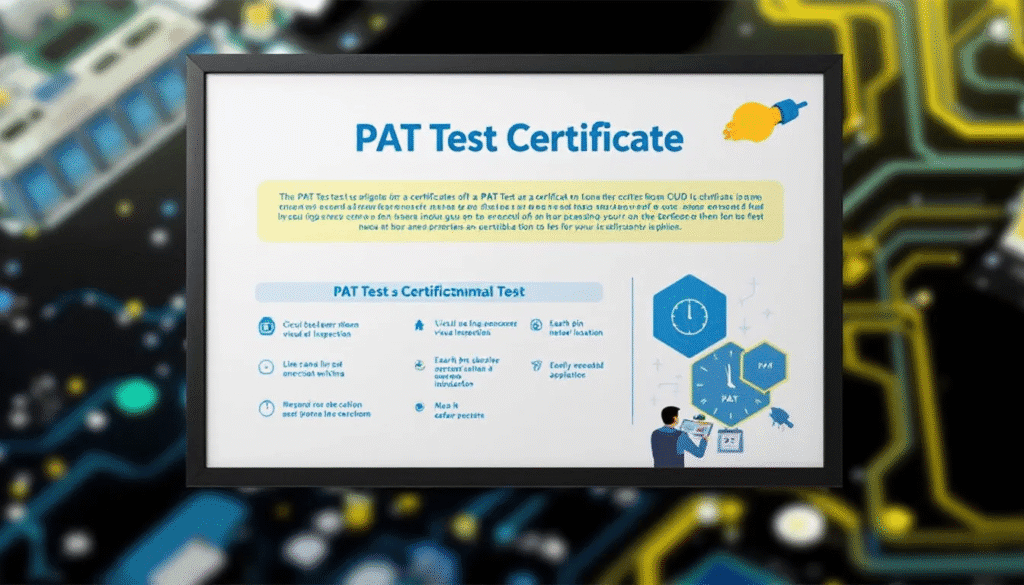What Is PAT Testing And Why Should You Do It?
- Key Takeaways
- Understanding PAT Testing
- Components of a PAT Test
- Why PAT Testing is Important
- Legal Requirements for PAT Testing
- Types of Electrical Equipment Covered by PAT Testing
- How Often Should You Conduct PAT Testing?
- Who Can Perform PAT Testing?
- What Does a PAT Test Certificate Include?
- The Process of Getting a PAT Test Certificate
- Common Myths About PAT Testing
- Summary
- Frequently Asked Questions
A PAT test, or Portable Appliance Test, is a regular examination of electrical devices to verify their safety for use. It involves checking both the physical condition and internal workings of an appliance to identify potential hazards that could lead to electrical accidents. This guide will explain what a PAT test is, what PAT testing entails, why it is essential for safety, and how it is conducted.
Key Takeaways
- PAT testing ensures the safety of portable electrical equipment through visual inspections and electrical tests, identifying potential hazards and preventing accidents.
- Compliance with PAT testing regulations is crucial for maintaining workplace safety and avoiding legal repercussions, even though PAT testing itself is not legally mandated.
- A competent person can perform PAT tests, and the frequency of testing should be based on the equipment’s usage and risk factors to ensure ongoing safety and compliance.
Understanding PAT Testing

PAT testing stands for Portable Appliance Testing. It involves checking portable electrical equipment for safety. This process encompasses both visual inspections and manual electrical examinations, aiming to identify any potential hazards before they can cause harm, including further portable appliance tests and annual portable appliance testing.
The primary goal of PAT testing is to confirm that electrical equipment is safe for use, thereby preventing accidents such as electrical shocks, burns, or even fires. Visual inspections check for signs of wear and tear, while testing of electrical systems reveals less obvious issues that could compromise safety.
Regular PAT tests ensure compliance with safety regulations and contribute to a safer working environment for the safety executive. Keeping portable electrical equipment in good working order mitigates risks and enhances overall workplace safety.
Components of a PAT Test
A PAT test consists of several key components, beginning with a visual inspection. This step focuses on identifying visible damage or wear on the appliance, its cable, and plug. Proper lighting and tools enhance the effectiveness of these inspections, helping detect less obvious faults.
A successful formal visual inspection ensures there are no frayed cables, loose plugs, or obvious signs of overheating, including visual checks on extension leads. These checks help prevent accidents by identifying potential trip hazards and fire hazards early during the in-service inspection.
Following the visual inspection, the process involves a series of electrical tests and electrical testing. These tests check for issues such as earth continuity, earth continuity test, insulation resistance test, and lead polarity, ensuring that the appliances tested operate safely under normal conditions. Combining visual and electrical inspections provides a comprehensive safety check for portable appliances using portable appliance testers.
Why PAT Testing is Important

PAT testing prevents electrical hazards that could lead to serious accidents, playing a critical role in ensuring safety. Regular PAT testing identifies potential equipment failures before they disrupt operations, maintaining productivity and safety.
Compliance with PAT testing regulations is both a legal responsibility and a proactive measure to protect employees and maintain business integrity. Neglecting PAT testing can lead to consequences like electric shocks, burns, or fires from poorly maintained equipment.
Visual inspections add an extra layer of monitoring for electrical safety, even for equipment not formally tested. Neglecting PAT testing increases the risk of accidents and breaches of health and safety regulations, leading to legal repercussions. Inspection and testing are essential for maintaining compliance.
Legal Requirements for PAT Testing
While PAT testing is not explicitly mandated by law, it is considered good practice for complying with safety regulations. The Electricity at Work Regulations 1989 require that electrical equipment must be maintained in a safe condition, ensuring the health, safety, and welfare of all employees.
Adhering to PAT testing regulations avoids legal repercussions and demonstrates a commitment to safety. An up-to-date PAT test certificate is crucial for businesses to protect their insurance coverage and meet legal responsibilities.
Experts recommend PAT testing as part of a risk-based approach to electrical safety, especially for newly purchased equipment. This proactive approach helps ensure that all electrical appliances remain safe for use.
Types of Electrical Equipment Covered by PAT Testing
PAT testing covers a variety of portable electrical equipment and portable equipment, including laptops, desktop computers, drills, kettles, and heaters. These devices are crucial in everyday operations and must be maintained as portable electric equipment to ensure safety using PAT testing equipment and portable appliance maintenance.
Portable electrical equipment is classified into two categories: Class I and Class II. Class I equipment requires an earth connection and includes items such as toasters, kettles, microwaves, and fridges. Class II equipment, on the other hand, uses extra insulation and includes devices like drills, hedge trimmers, photocopiers, and computers.
Knowing which equipment requires PAT testing ensures all necessary devices are checked and maintained, reducing electrical hazards.
How Often Should You Conduct PAT Testing?
Determining the frequency of PAT testing involves a risk-based approach. Employers should assess the type of appliance and its usage to determine appropriate annual testing intervals. The law mandates maintaining electrical equipment to prevent danger, but does not specify testing frequency.
Therefore, equipment that is frequently moved or used, such as floor cleaners or kettles, may require more regular testing. A low-risk approach ensures each piece of equipment is tested as often as necessary, balancing safety with practicality for the foreseeable future.
Who Can Perform PAT Testing?
Anyone deemed competent can perform a PAT test without necessarily being a qualified electrician. A competent person should have sufficient knowledge and training to carry out PAT testing and document the results.
Duty holders or designated staff members should be responsible for conducting PAT tests in the workplace, especially in cases of multiple occupation. Staff with some training can perform user checks and visual inspections of electrical equipment.
Training courses are available to equip staff with the skills to perform PAT testing effectively. Choosing a good method for a reputable PAT testing service ensures thorough testing and accurate documentation.
What Does a PAT Test Certificate Include?
A PAT test certificate details the testing process and appliance information. It contains important information such as the address of the testing site, an authorised signature, and unique reference numbers for each appliance.
It also summarises testing results and indicates the certification validity period. Photos of any failed equipment may be included to help identify the reasons for non-compliance.
The Process of Getting a PAT Test Certificate

To obtain a PAT test certificate, identify appliances needing testing to ensure compliance and safety. Before the PAT tester arrives, power off all appliances and inform staff of the testing schedule.
The PAT test includes performing visual inspections and tests on the identified appliances. Upon completing the tests, you will receive a PAT test certificate with the test results, the next test date, and details from previous tests conducted by a qualified PAT tester.
For those looking to enhance their skills in conducting PAT testing, consider enrolling in a workshop on electrical safety and testing techniques. Check out the available courses at Evolve Training to become proficient in PAT testing and ensure your workplace remains compliant and safe.
Common Myths About PAT Testing
Many common myths exist about PAT testing, such as the belief that it guarantees complete electrical safety, which is not true; additional measures are necessary. The cost and time involved in PAT testing can vary, and there are efficient methods to streamline the process.
Another myth is that battery-operated devices that are not connected to mains power require PAT testing, which is generally not the case. Evidence suggests clarifying these myths aids in making informed decisions about electrical safety.
Summary
Summarising the key points discussed, PAT testing is crucial for ensuring electrical safety in the workplace. It involves a combination of visual inspections and electrical tests, aiming to identify and mitigate potential hazards.
Understanding the legal requirements and the types of equipment covered by PAT testing helps in maintaining a safe working environment. Regular PAT testing is a proactive measure to prevent accidents and ensure compliance with safety regulations.








